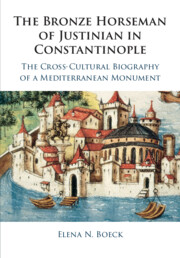 The Bronze Horseman of Justinian in Constantinople
The Bronze Horseman of Justinian in Constantinople Published online by Cambridge University Press: 08 April 2021
For intellectuals of the re-conquest generation, Prokopios became a helpful guide to the city they had lost and regained. George Pachymeres (1242–ca. 1308), a highly placed court historian, engaged in an intertextual dialogue with the lengthy account of the horseman written by Prokopios. Pachymeres set out to write an exemplary ekphrasis that would outperform Prokopios in vivid explication of Justinian’s monument. The narrative structure follows Prokopios, but emphasizes different points. Pachymeres created a narrative contrast between the Constantinople of his own days and the glorious Constantinople of earlier times by focusing on the horseman – the tangible imperial link that threaded together two eras. The narrative offered by Pachymeres provides a lens through which we can behold the experience of an intellectual returning from exile and a learned observer examining a monument of a glorious past. His extended description of the monument sought to reconstruct its creator’s reasoning by using his own powers of observation, thus addressing a failure of Prokopios. Pachymeres can therefore be considered an eager, early pioneer of the fertile terrain that is now known as "late antique studies."
To save this book to your Kindle, first ensure [email protected] is added to your Approved Personal Document E-mail List under your Personal Document Settings on the Manage Your Content and Devices page of your Amazon account. Then enter the ‘name’ part of your Kindle email address below. Find out more about saving to your Kindle.
Note you can select to save to either the @free.kindle.com or @kindle.com variations. ‘@free.kindle.com’ emails are free but can only be saved to your device when it is connected to wi-fi. ‘@kindle.com’ emails can be delivered even when you are not connected to wi-fi, but note that service fees apply.
Find out more about the Kindle Personal Document Service.
To save content items to your account, please confirm that you agree to abide by our usage policies. If this is the first time you use this feature, you will be asked to authorise Cambridge Core to connect with your account. Find out more about saving content to Dropbox.
To save content items to your account, please confirm that you agree to abide by our usage policies. If this is the first time you use this feature, you will be asked to authorise Cambridge Core to connect with your account. Find out more about saving content to Google Drive.